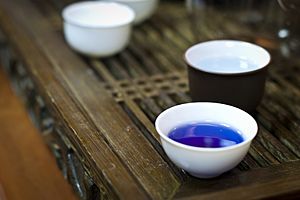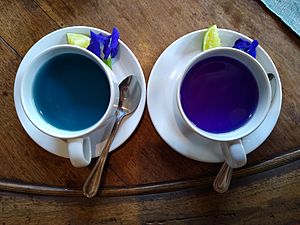Butterfly pea flower tea facts for kids

Butterfly-pea flower tea brewing in a pot
|
|
| Alternative names | Butterfly-pea leaf tea |
|---|---|
| Type | Herbal tea |
| Course | Drink |
| Region or state | South East Asia |
| Cooking time | |
| Serving temperature | Hot or cold |
| Main ingredients | Butterfly-pea flowers |
| Ingredients generally used | dried lemongrass |
| Variations | nam dok anchan |
Butterfly pea flower tea, also called blue tea, is a special drink made from the petals of the Clitoria ternatea plant. This plant is also known as butterfly pea, blue pea, or Asian pigeonwings. Unlike many teas, it does not have caffeine. It is a type of herbal tea, which means it's made from plants, not tea leaves.
This unique tea comes from a plant common in South East Asia. People there have been making it for hundreds of years. It has only recently become popular in other parts of the world. The tea gets its amazing deep blue color from the flower petals. These petals have been used as a dye for centuries. One of the coolest things about this tea is that its color changes! If you add something like lemon juice, which is acidic, the blue tea will turn purple.
Some people believe that butterfly pea flowers have special health benefits. They are used in traditional medicine systems like Ayurveda.
Contents
Where does butterfly pea tea come from?
The Clitoria ternatea plant, also called butterfly pea, grows naturally across South East Asia. It belongs to the pea family. For a long time, people in this region have used the bright blue flowers to make herbal tea. They also use the flowers to add color to food, like the rice dish nasi kerabu.
In countries like Thailand and Vietnam, butterfly pea flower tea is often mixed with honey and lemon. This drink is called nam dok anchan in Thai. It is usually served after dinner or as a refreshing drink in hotels and spas. Many people think of nam dok anchan as a common local drink, much like chamomile tea is in other places. You can drink it hot or cold. The cold version is often mixed with honey, mint, cinnamon, passion fruit, or ginger.
For many years, butterfly pea flower tea was mostly known only in South East Asia. But thanks to travel shows and food blogging, more people around the world are now discovering it. It is not yet easy to find in regular supermarkets. You can mostly buy it from special online stores.
People describe the taste of this tea as "earthy and woody." Some say it tastes more like a good green tea than a sweet drink.
Why is butterfly pea tea so popular?
The most amazing thing about butterfly pea flower tea is how its color changes. This happens when the pH balance of the liquid changes. If you add lemon juice to the deep blue tea, it will turn purple. The more lemon juice you add, the deeper purple it becomes. If you mix it with fuchsia roselle hibiscus leaves, the tea can even turn a bright red color!
This color-changing magic makes the tea popular in cocktails. Bartenders can show off by making the drink change color right in front of customers. Another fun idea is to freeze the tea into ice cubes. As the ice cubes melt in a drink, they slowly change its color. This has been called a "mood ring cocktail."
In the United States, the Food and Drug Administration (FDA) has said that "butterfly pea flower extract" is safe to use as a food additive.
Images for kids
See also
 In Spanish: Té anchan para niños
In Spanish: Té anchan para niños





